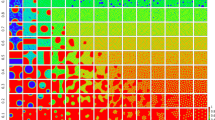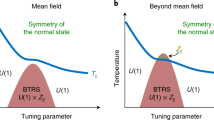Abstract
One view of the high-transition-temperature (high-Tc) copper oxide superconductors is that they are conventional superconductors where the pairing occurs between weakly interacting quasiparticles (corresponding to the electrons in ordinary metals), although the theory has to be pushed to its limit1. An alternative view is that the electrons organize into collective textures (for example, charge and spin stripes) which cannot be ‘mapped’ onto the electrons in ordinary metals. Understanding the properties of the material would then need quantum field theories of objects such as textures and strings, rather than point-like electrons2,3,4,5,6. In an external magnetic field, magnetic flux penetrates type II superconductors via vortices, each carrying one flux quantum7. The vortices form lattices of resistive material embedded in the non-resistive superconductor, and can reveal the nature of the ground state—for example, a conventional metal or an ordered, striped phase—which would have appeared had superconductivity not intervened, and which provides the best starting point for a pairing theory. Here we report that for one high-Tc superconductor, the applied field that imposes the vortex lattice also induces ‘striped’ antiferromagnetic order. Ordinary quasiparticle models can account for neither the strength of the order nor the nearly field-independent antiferromagnetic transition temperature observed in our measurements.
This is a preview of subscription content, access via your institution
Access options
Subscribe to this journal
Receive 51 print issues and online access
$199.00 per year
only $3.90 per issue
Buy this article
- Purchase on Springer Link
- Instant access to full article PDF
Prices may be subject to local taxes which are calculated during checkout



Similar content being viewed by others
References
Monthoux, P., Balatsky, A. V. & Pines, D. Weak-coupling theory of high-temperature superconductivity in the antiferromagnetically correlated copper oxides. Phys. Rev. B 46, 14803–14817 (1992).
Zaanen, J. & Gunnarson, O. Charged magnetic domain lines and the magnetism of high-T c oxides. Phys. Rev. B 40, 7391–7394 (1989).
Tranquada, J. M. et al. Evidence for stripe correlations of spins and holes in copper-oxide superconductors. Nature 375, 561–563 (1995).
Kivelson, S. A., Fradkin, E. & Emery, V. J. Electronic liquid-crystal phases of a doped Mott insulator. Nature 393, 550–553 (1998).
Zaanen, J. Stripes defeat the Fermi liquid. Nature 404, 714–715 (2000).
Zaanen, J., Osman, O. Y. & van Saarloos, W. Metallic stripes: separation of spin, charge, and string fluctuation. Phys. Rev. B 58, R11868–R11871 (1998).
Kittel, C. Introduction to Solid State Physics 6th edn, 317–358 (Wiley & Sons, New York, 1986).
Vaknin, D. et al. Antiferromagnetism in La2CuO4. Phys. Rev. Lett. 58, 2802–2805 (1987).
Lee, Y. S. et al. Neutron-scattering study of spin-density wave order in the superconducting state of excess-oxygen-doped La2CuO4+y. Phys. Rev. B 60, 3643–3654 (1999).
Kimura, H. et al. Neutron-scattering study of static antiferromagnetic correlations in La2-xSrxCu1-yZnyO4. Phys. Rev. B 59, 6517–6523 (1999).
Andoh, Y. et al. Resistive upper critical fields and irreversibility lines of optimally doped high-Tc cuprates. Phys. Rev. B 60, 12475–12479 (1999).
Lake, B. et al. Spin gap and magnetic coherence in a clean high-temperature superconductor. Nature 400, 43–46 (1999).
Wakimoto, S., Birgeneau, R. J., Lee, Y. S. & Shirane, G. Hole concentration dependence of the magnetic moment in superconducting and insulating La2-xSrxCuO4. Phys. Rev. B 63, 172501–172505 (2001).
Katano, S., Sato, M., Yamada, K., Suzuki, T. & Fukase, T. Enhancement of static antiferromagnetic correlations by magnetic field in a superconductor La2-xSrxCuO4 with x = 0.12. Phys. Rev. B 62, R14677–R14680 (2000).
Lake, B. et al. Spins in the vortices of a high temperature superconductor. Science 291, 832–834 (2001).
Nohara, M. et al. Quasiparticle density of states of clean and dirty d-wave superconductors: mixed-state specific heat of La2-xSrxCuO4. J. Phys. Soc. Jpn 69, 1602–1605 (2001).
Lake, B. et al. Antiferromagnetic vortex state in a high-temperature superconductor. Preprint cond-mat/0104026 at 〈http://xxx.lanl.gov〉 (2001).
Savici, A. T. et al. Static magnetism in superconducting stage-4 La2CuO4+y (y = 0.12). Physica B 289–290, 338–342 (2000).
Aeppli, G. et al. Magnetic order and fluctuations in superconducting UPt3. Phys. Rev. Lett. 60, 615–618 (1988).
Arovas, D. P., Berlinsky, A. J., Kallin, C. & Zhang, S.-C. Superconducting vortex with antiferromagnetic core. Phys. Rev. Lett. 79, 2871–2874 (1997).
Hedegård, P. Magnetic vortices in high-temperature superconductors. Preprint cond-mat/0102070 at 〈http://xxx.lanl.gov〉 (2001).
Hu, J.-P. & Zhang, S.-C. Theory of static and dynamic antiferromagnetic vortices in LSCO superconductor. Preprint cond-mat/0108273 at 〈http://xxx.lanl.gov〉 (2001).
Demler, E., Sachdev, S. & Zhang, Y. Spin ordering quantum transitions of superconductors in a magnetic field. Phys. Rev. Lett. 87, 067202–067205 (2001).
Aeppli, G. et al. Nearly singular magnetic fluctuations in the normal state of a high-Tc superconductor. Science 278, 432–435 (1997).
Boebinger, G. S. et al. Insulator-to-metal crossover in the normal state of La2-xSrxCuO4 near optimal doping. Phys. Rev. Lett. 77, 5417–5420 (1996).
Kittel, C. Introduction to Solid State Physics 6th edn, 426–428 (Wiley & Sons, New York, 1986).
Acknowledgements
We thank P. Dai, P. Hedegård, S. Kivelson, H. Mook, J. Zaanen, S. Sachdev and S.-C. Zhang for discussions. Oak Ridge National Laboratory is managed by UT-Battelle, LLC, for the US Department of Energy. H.M.R. holds a Marie Curie fellowship funded by the European Community.
Author information
Authors and Affiliations
Corresponding author
Rights and permissions
About this article
Cite this article
Lake, B., Rønnow, H., Christensen, N. et al. Antiferromagnetic order induced by an applied magnetic field in a high-temperature superconductor. Nature 415, 299–302 (2002). https://doi.org/10.1038/415299a
Received:
Accepted:
Issue Date:
DOI: https://doi.org/10.1038/415299a
This article is cited by
-
Fate of charge order in overdoped La-based cuprates
npj Quantum Materials (2023)
-
Co-appearance of superconductivity and ferromagnetism in a Ca2RuO4 nanofilm crystal
Scientific Reports (2020)
-
Hidden magnetism at the pseudogap critical point of a cuprate superconductor
Nature Physics (2020)
-
Pair density wave at high magnetic fields in cuprates with charge and spin orders
Nature Communications (2020)
-
Observation of two types of charge-density-wave orders in superconducting La2-xSrxCuO4
Nature Communications (2019)
Comments
By submitting a comment you agree to abide by our Terms and Community Guidelines. If you find something abusive or that does not comply with our terms or guidelines please flag it as inappropriate.



